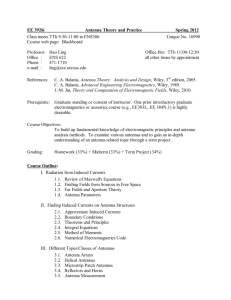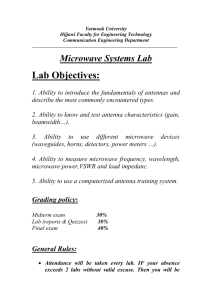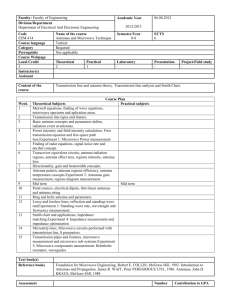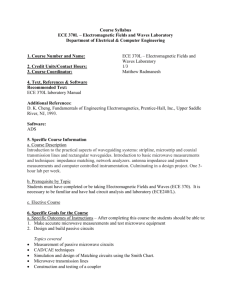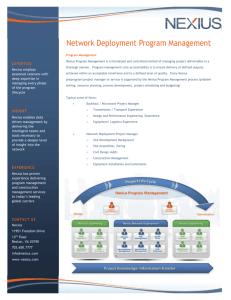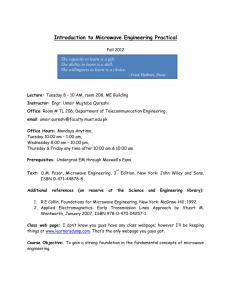Ethics - ASEE Brookings 2005 - North Dakota State University
advertisement
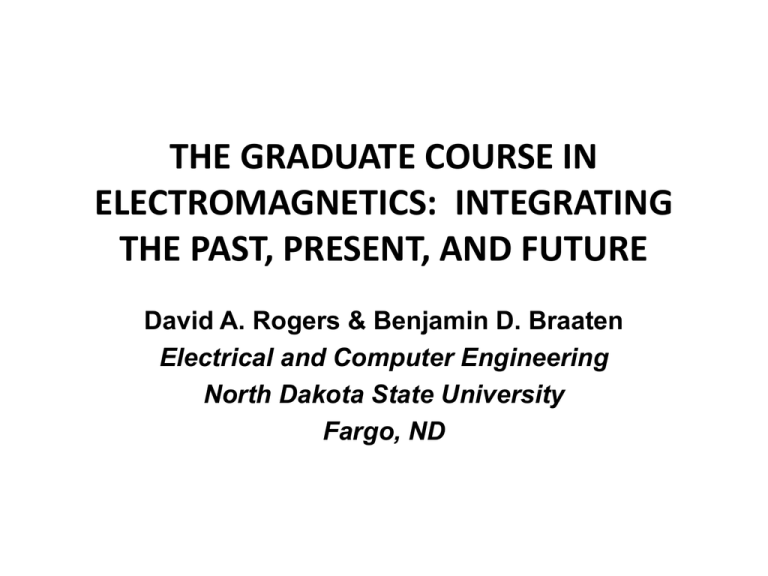
THE GRADUATE COURSE IN ELECTROMAGNETICS: INTEGRATING THE PAST, PRESENT, AND FUTURE David A. Rogers & Benjamin D. Braaten Electrical and Computer Engineering North Dakota State University Fargo, ND First Graduate Course in Electromagnetics • 30-50 years ago – textbooks by Plonsey and Collin and Collin • Emphasized: • • • • Maxwell’s Equations Analytical Solutions: open- and closed structures Followed undergrad cousin with increased rigor Theoretical emphasis increased following Sputnik • Thorough vector calculus descriptions Typical outline 50 years ago • • • • • • • • Gauss’s flux and divergence theorems Poisson’s equation Three common coordinate systems Curvilinear coordinates Green’s identities Dirichlet and Neumann conditions Uniqueness Theorem In essence, quite theoretical/mathematical Early Textbook Details • Plonsey, R. and Collin, R. E. (1961). Principles and Applications of Electromagnetic Fields. New York, NY: McGraw-Hill. • Collin, R. E. (2001). Foundations for Microwave Engineering. New York, NY: IEEE Press. Grad Course in Electromagnetics 20-30 years ago. • Textbooks by Pozar, Balanis, Ishimaru • Advanced electromagnetics • • • • • • Boundary value problems Reflection and transmission Microwave device design and analysis Microstrip design techniques Microwave filters Microwave networks 20-30 years ago (continued) • • • • • Waveguides using vector potential methods Magneto-ionic media Propagation in the neutral atmosphere Cavities Intermediate mathematics of electromagnetics Classical Textbook Details • Balanis, C. A. (2012). Advanced Engineering Electromagnetics. Hoboken, NJ: Wiley. • Ishimaru, A. (1991). Electromagnetic Wave Propagation, Radiation, and Scattering. Englewood Cliffs, NJ: Prentice Hall. • Pozar, D. M. (2005). Microwave Engineering. Hoboken, NJ: Wiley. A Contemporary Course • Maxwell’s equations review • Plane waves, lossy media, reflection and transmission • Transmission-line theory, losses, matching stubs • Microstrip design • Microstrip devices: couplers, splitters, matching devices • Metallic waveguides • General solutions for guided-wave structures • Human effects of electromagnetic waves/ethics A Contemporary Course (Continued) • • • • • • • Microwave network theory Antennas, gain, noise, and systems studies Radio propagation and scattering Magneto-ionic theory Fiber optics Matrix method in networks Project presentations Contemporary Textbook Details • Pozar, D. M. (2012). Microwave Engineering. Hoboken, NJ: Wiley. • 2012 edition is scheduled for release in November 2011. What will our students need? • Course should serve grad students specializing in electromagnetics. • Should attract non-specialists. • Serve those working with high-speed or very small devices—material science, nanoscale science/engineering, certain areas of applied physics, and specialists in optics. What do the students bring to the course? • • • • • An undergraduate electromagnetics course. Phasor analysis of AC circuits. Transmission line theory. Plane wave background. The usual physics and math common to undergrad engineering and physics students. Computer and laboratory work • Early in the semester students begin a project, groups of two or three students. • Design a microwave device. • Layout and simulate on the computer. • Forward to ProtoMat S62 milling machine. (www.lpkf.com ) • Measure using Agilent E5071C (4.5 GHz) network analyzer. • Compare to Advanced Design System (ADS) and Matlab simulations. • Present oral and written reports. Have we had an impact on the students? • Gets students involved in: • • • • • Literature searches Reproducing published results New designs, new frequencies ADS layouts and simulations Testing • In the course: • Reduce routine homework in favor of the above. • Require student bi-weekly written progress reports and oral presentations. • Final report to be ready for submission to a conference. Student Project Procedure: Example: 90o Hybrid Coupler • Design device based on Pozar or other literature/research. • Lay out and simulate device using ADS. • Send gerber file to ProtoMat S62 PCB milling machine. • Add connectors and loads to the device. • Determine the performance (scattering parameters) using an Agilent E5071C spectrum analyzer. ADS Layout for 90o Hybrid Coupler ProtoMat S62 PCB milling machine http://sites.google.com/site/ndsuece/Home Waiting for the Grad Assistant 90o Hybrid Coupler Network Analyzer Network Analyzer close-up dB 1.50 1.58 1.65 1.73 1.80 1.88 1.95 2.03 2.10 2.18 2.25 2.33 2.40 2.48 2.55 2.63 2.70 2.78 2.85 2.93 3.00 3.08 3.15 3.23 3.30 3.38 3.45 3.53 3.60 3.68 3.75 3.83 3.90 3.98 4.05 4.12 4.20 4.28 4.35 4.42 4.50 Test Results: 90o Hybrid Coupler S Parameters 0.00 -30.00 -35.00 -40.00 GHz -3.97 -5.00 -5.33 -10.00 -15.00 S11 S12 -20.00 -21.43 S13 S14 -25.00 -28.92 Design fo = 3Ghz More Student Project Results • Power dividers • “Rat race” coupler • Quasi-Yagi antenna • Quasi-Landstorfer antenna • Bow-tie slot antenna Student Projects: Power Dividers Power divider without resistor -15 Power divider with resistor -3.0 -12 -3.5 -3.5 -4.0 -18 -4.0 -20 -30 (1.53, -29.33) -35 S11-simulation S11-measured 1.0 (1.486,-36.986) 1.2 1.4 1.6 Frequency (GHz) 1.8 -6.0 IS11I (dB) IS11I (dB) -5.5 -24 -5.0 -30 (1.549,-28.62) -5.5 -6.0 -36 S11-Measured S11-Simulated -6.5 -42 (1.597,-44.206) -7.0 2.0 -6.5 -7.0 1.0 1.2 1.4 1.6 Frequency (GHz) 1.8 2.0 IS12I, IS21I) (dB) -5.0 -25 -4.5 IS21I, IS12I (dB) -4.5 Student Project: “Rat Race” Coupler Student Project: Metamaterial-based Quasi-Yagi Antenna Student Project: A Quasi-Landstorfer Antenna Student Project: Bow-tie Slot Antenna Published/Accepted Results J. Anderson, K. Johnson, C. Satterlee, A. Lynch and B. D. Braaten, "A Reduced Frequency Printed Quasi-Yagi Antenna Symmetrically Loaded with Meander Open Complementary Split Ring Resonator (MOCSRR) Elements," Proceedings of the 2011 IEEE International Symposium on Antennas and Propagation, Spokane, WA, July 2011. M. A. Aziz, S. Roy and B. D. Braaten, "A New Printed QuasiLanstorfer Antenna," Accepted for publication in the IEEE Transactions on Antennas and Propagation. L. A. Berge, M. Reich and B. D. Braaten, “A Compact Dual-Band Pseudo-Vivaldi Bowtie Slot Antenna for 900 and 2400 MHz ISM Bands,” Submitted for review in the IEEE Antennas and Wireless Propagation Letters – Accepted and under revision. What are our plans for the department? • Recruit talented students to participate and be student leaders. • Integrate active research projects into teaching (Dr. Braaten). • Active interests: flexible antennas, printed antennas, microwave devices. • Leverage course activities to increase research in department. Conclusions • The course has been an excellent research initiation experience for our students. • It has drawn students and faculty together in ways that a straight lecture course couldn’t. • It has been the first step towards several M.S. degrees and a few Ph.D. degrees. Acknowledgement • Dr. Robert M. Nelson of UW-Stout made major contributions to the Emag program at NDSU, 1989-2008. He continues to be an inspiration for our work. Questions? Thank you for listening!

